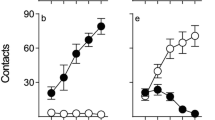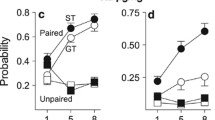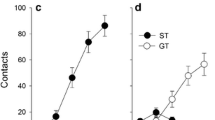Abstract
Rationale
Individuals prone to attribute incentive salience to food-associated stimuli (“cues”) are also more sensitive to cues during drug seeking and drug taking. This may be due in part to a difference in sensitivity to the affective or other stimulus properties of the drug. In rats, these properties are associated with 50-kHz ultrasonic vocalizations (USVs), in that they are elicited during putative positive affective and motivational states, including in response to drugs of abuse.
Objectives
We sought to determine whether individual differences in the tendency to attribute incentive salience to a food cue (as measured by approach) were associated with differences in cocaine-induced USVs. We also tested whether the food cue would elicit USVs and if this response was related to approach to the food cue.
Methods
In experiment 1, rats underwent Pavlovian conditioned approach (PavCA) training where they learned to associate a cue (an illuminated lever) with the delivery of a food pellet into a food cup. Subjects were categorized based on their approach to the cue (“sign-trackers”) or to the food cup (“goal-trackers”). Rats subsequently underwent nine testing days in which they were given saline or cocaine (10 mg/kg i.p) and placed into a locomotor chamber.
In experiment 2, rats were first tested in the locomotor chambers for one saline-treated day followed by one cocaine-treated day and then trained in PavCA. USVs were recorded from a subset of individuals during the last day of PavCA to determine if the food cue would elicit USVs.
Results
Sign-trackers produced 5–24 times more cocaine-induced 50 kHz USVs compared to goal-trackers for all days of experiment 1, and this response sensitized with repeated cocaine, only in sign-trackers. Similarly in experiment 2, individuals that produced the most cocaine-induced USVs on a single exposure also showed the greatest tendency to sign-track during PavCA. Lastly, while sign-trackers produced more USVs during PavCA generally, the cue itself did not elicit additional USVs in sign- or goal-trackers.
Conclusions
These results indicate a robust and consistent relationship between approach to a food cue and cocaine-induced USV production. Thus, these USVs may index the neurobiological differences underlying the behavioral distinctions of sign- and goal-trackers.




Similar content being viewed by others
References
Ahrens AM, Ma ST, Maier EY, Duvauchelle CL, Schallert T (2009) Repeated intravenous amphetamine exposure: rapid and persistent sensitization of 50-kHz ultrasonic trill calls in rats. Behavioral Brain Research 197:205–209
Beckmann JS, Marusich JA, Gipson CD, Bardo MT (2011) Novelty seeking, incentive salience and acquisition of cocaine self-administration in the rat. Behavioral Brain Research 216:159–165
Berridge KC (2001) Reward learning: reinforcement, incentives, and expectations. In: Medin DL (ed) Psychology of learning and motivation: advances in research and theory. Academic Press Inc., New York, pp. 223–278
Berridge KC, Robinson TE, Aldridge JW (2009) Dissecting components of reward: ‘liking’, ‘wanting’, and learning. Curr Opin Pharmacol 9:65–73
Bialy M, Rydz M, Kaczmarek L (2000) Precontact 50-kHz vocalizations in male rats during acquisition of sexual experience. Behav Neurosci 114:983–990
Bindra D (1978) How adaptive behavior is produced: a perceptual-motivation alternative to response reinforcement. Behavioral Brain Research 1:41–91
Boakes R (1977) Performance on learning to associate a stimulus with positive reinforcement. In: Davis H, Hurwitz H (eds) Operant-Pavlovian interactions. Lawrence Erlbaum Associates, Hillsdale, pp. 67–97
Brenes JC, Schwarting RK (2014) Attribution and expression of incentive salience are differentially signaled by ultrasonic vocalizations in rats. PLoS One 9:e102414
Brenes JC, Schwarting RK (2015) Individual differences in anticipatory activity to food rewards predict cue-induced appetitive 50-kHz calls in rats. Physiol Behav 149:107–118
Browning JR, Browning DA, Maxwell AO, Dong Y, Jansen HT, Panksepp J, Sorg BA (2011) Positive affective vocalizations during cocaine and sucrose self-administration: a model for spontaneous drug desire in rats. Neuropharmacology 61:268–275
Brudzynski SM (2005) Principles of rat communication: quantitative parameters of ultrasonic calls in rats. Behav Genet 35:85–92
Brudzynski SM (2013) Ethotransmission: communication of emotional states through ultrasonic vocalization in rats. Curr Opin Neurobiol 23:310–317
Burgdorf J, Knutson B, Panksepp J (2000) Anticipation of rewarding electrical brain stimulation evokes ultrasonic vocalization in rats. Behav Neurosci 114:320–327
Burgdorf J, Knutson B, Panksepp J, Ikemoto S (2001) Nucleus accumbens amphetamine microinjections unconditionally elicit 50-kHz ultrasonic vocalizations in rats. Behav Neurosci 115:940–944
Burgdorf J, Kroes RA, Moskal JR, Pfaus JG, Brudzynski SM, Panksepp J (2008) Ultrasonic vocalizations of rats (Rattus norvegicus) during mating, play, and aggression: behavioral concomitants, relationship to reward, and self-administration of playback. J Comp Psychol 122:357–367
Burgdorf J, Panksepp J, Beinfeld MC, Kroes RA, Moskal JR (2006) Regional brain cholecystokinin changes as a function of rough-and-tumble play behavior in adolescent rats. Peptides 27:172–177
Burgdorf J, Panksepp J, Brudzynski SM, Kroes R, Moskal JR (2005) Breeding for 50-kHz positive affective vocalization in rats. Behav Genet 35:67–72
Flagel SB, Akil H, Robinson TE (2009) Individual differences in the attribution of incentive salience to reward-related cues: implications for addiction. Neuropharmacology 56(Suppl 1):139–148
Flagel SB, Clark JJ, Robinson TE, Mayo L, Czuj A, Willuhn I, Akers CA, Clinton SM, Phillips PE, Akil H (2011) A selective role for dopamine in stimulus-reward learning. Nature 469:53–57
Flagel SB, Watson SJ, Akil H, Robinson TE (2008) Individual differences in the attribution of incentive salience to a reward-related cue: influence on cocaine sensitization. Behavioral Brain Research 186:48–56
Flagel SB, Watson SJ, Robinson TE, Akil H (2007) Individual differences in the propensity to approach signals vs goals promote different adaptations in the dopamine system of rats. Psychopharmacology 191:599–607
Garcia EJ, Cain ME (2016) Novelty response and 50 kHz ultrasonic vocalizations: differential prediction of locomotor and affective response to amphetamine in Sprague-Dawley rats. Psychopharmacology 233:625–637
Grimm JW, Hope BT, Wise RA, Shaham Y (2001) Neuroadaptation. Incubation of cocaine craving after withdrawal Nature 412:141–142
Hearst E, Jenkins HM (1974) Sign tracking: the stimulus-reinforcer relation and directed action. Proceedings of the Psychonomic Society, Austin, TX
Javaid JI, Davis JM (1993) Cocaine disposition in discrete regions of rat brain. Biopharm Drug Dispos 14:357–364
Knutson B, Burgdorf J, Panksepp J (1998) Anticipation of play elicits high-frequency ultrasonic vocalizations in young rats. J Comp Psychol 112:65–73
Knutson B, Burgdorf J, Panksepp J (1999) High-frequency ultrasonic vocalizations index conditioned pharmacological reward in rats. Physiol Behav 66:639–643
Knutson B, Burgdorf J, Panksepp J (2002) Ultrasonic vocalizations as indices of affective states in rats. Psychol Bull 128:961–977
Kruzich PJ, Congleton KM, See RE (2001) Conditioned reinstatement of drug-seeking behavior with a discrete compound stimulus classically conditioned with intravenous cocaine. Behav Neurosci 115:1086–1092
Ma ST, Maier EY, Ahrens AM, Schallert T, Duvauchelle CL (2010) Repeated intravenous cocaine experience: development and escalation of pre-drug anticipatory 50-kHz ultrasonic vocalizations in rats. Behavioral Brain Research 212:109–114
Mahler SV, de Wit H (2010) Cue-reactors: individual differences in cue-induced craving after food or smoking abstinence. PLoS One 5. doi:10.1371/journal.pone.0015475
Mahler SV, Moorman DE, Feltenstein MW, Cox BM, Ogburn KB, Bachar M, McGonigal JT, Ghee SM, See RE (2013) A rodent “self-report” measure of methamphetamine craving? Rat ultrasonic vocalizations during methamphetamine self-administration, extinction, and reinstatement. Behavioral Brain Research 236:78–89
Maier EY, Abdalla M, Ahrens AM, Schallert T, Duvauchelle CL (2012) The missing variable: ultrasonic vocalizations reveal hidden sensitization and tolerance-like effects during long-term cocaine administration. Psychopharmacology 219:1141–1152
Meyer PJ, Cogan ES, Robinson TE (2014) The form of a conditioned stimulus can influence the degree to which it acquires incentive motivational properties. PLoS One 9:e98163
Meyer PJ, Lovic V, Saunders BT, Yager LM, Flagel SB, Morrow JD, Robinson TE (2012a) Quantifying individual variation in the propensity to attribute incentive salience to reward cues. PLoS One 7:e38987
Meyer PJ, Ma ST, Robinson TE (2012b) A cocaine cue is more preferred and evokes more frequency-modulated 50-kHz ultrasonic vocalizations in rats prone to attribute incentive salience to a food cue. Psychopharmacology 219:999–1009
Mu P, Fuchs T, Saal DB, Sorg BA, Dong Y, Panksepp J (2009) Repeated cocaine exposure induces sensitization of ultrasonic vocalization in rats. Neurosci Lett 453:31–35
Panksepp J, Burgdorf J (2000) 50-kHz chirping (laughter?) in response to conditioned and unconditioned tickle-induced reward in rats: effects of social housing and genetic variables. Behavioral Brain Research 115:25–38
Panksepp J, Knutson B, Burgdorf J (2002) The role of brain emotional systems in addictions: a neuro-evolutionary perspective and new ‘self-report’ animal model. Addiction 97:459–469
Pavlov IP (1927) Conditioned reflexes: an investigation of the physiological activity of the cerebral cortex. Oxford University Press, London
Pierce RC, Kalivas PW (1997) Repeated cocaine modifies the mechanism by which amphetamine releases dopamine. J Neurosci 17:3254–3261
Portfors CV, Perkel DJ (2014) The role of ultrasonic vocalizations in mouse communication. Curr Opin Neurobiol 28:115–120
Radziwon KE, Dent ML (2014) Frequency difference limens and auditory cue trading in CBA/CaJ mice (Mus musculus). Behav Process 106:74–76
Robinson TE, Flagel SB (2009) Dissociating the predictive and incentive motivational properties of reward-related cues through the study of individual differences. Biol Psychiatry 65:869–873
Robinson TE, Yager LM, Cogan ES, Saunders BT (2014) On the motivational properties of reward cues: individual differences. Neuropharmacology 76 Part B:450–459
Saunders BT, Robinson TE (2010) A cocaine cue acts as an incentive stimulus in some but not others: implications for addiction. Biol Psychiatry 67:730–736
Saunders BT, Robinson TE (2011) Individual variation in the motivational properties of cocaine. Neuropsychopharmacology 36:1668–1676
Saunders BT, Robinson TE (2012) The role of dopamine in the accumbens core in the expression of Pavlovian-conditioned responses. Eur J Neurosci 36:2521–2532
Saunders BT, Robinson TE (2013) Individual variation in resisting temptation: implications for addiction. Neurosci Biobehav Rev 37:1955–1975
Schwarting RK, Jegan N, Wohr M (2007) Situational factors, conditions and individual variables which can determine ultrasonic vocalizations in male adult Wistar rats. Behavioral Brain Research 182:208–222
Shaham Y, Shalev U, Lu L, De Wit H, Stewart J (2003) The reinstatement model of drug relapse: history, methodology and major findings. Psychopharmacology 168:3–20
Simola N, Morelli M (2015) Repeated amphetamine administration and long-term effects on 50-kHz ultrasonic vocalizations: possible relevance to the motivational and dopamine-stimulating properties of the drug. Eur Neuropsychopharmacol 25:343–355
Tomie A, Aguado AS, Pohorecky LA, Benjamin D (2000) Individual differences in pavlovian autoshaping of lever pressing in rats predict stress-induced corticosterone release and mesolimbic levels of monoamines. Pharmacol Biochem Behav 65:509–517
Tomie A, Grimes KL, Pohorecky LA (2008) Behavioral characteristics and neurobiological substrates shared by Pavlovian sign-tracking and drug abuse. Brain Res Rev 58:121–135
Vanderschuren LJ, Kalivas PW (2000) Alterations in dopaminergic and glutamatergic transmission in the induction and expression of behavioral sensitization: a critical review of preclinical studies. Psychopharmacology 151:99–120
Versaggi C, King C, Meyer P (2016) The tendency to sign-track predicts cue-induced reinforcement during nicotine self-administration, and is enhanced by nicotine but not ethanol. Psychopharmacology
Willuhn I, Tose A, Wanat MJ, Hart AS, Hollon NG, Phillips PE, Schwarting RK, Wohr M (2014) Phasic dopamine release in the nucleus accumbens in response to pro-social 50 kHz ultrasonic vocalizations in rats. J Neurosci 34:10616–10623
Wohr M, Houx B, Schwarting RK, Spruijt B (2008) Effects of experience and context on 50-kHz vocalizations in rats. Physiol Behav 93:766–776
Wohr M, Schwarting RK (2013) Affective communication in rodents: ultrasonic vocalizations as a tool for research on emotion and motivation. Cell Tissue Res 354:81–97
Wright JM, Gourdon JC, Clarke PB (2010) Identification of multiple call categories within the rich repertoire of adult rat 50-kHz ultrasonic vocalizations: effects of amphetamine and social context. Psychopharmacology 211:1–13
Yager LM, Robinson TE (2010) Cue-induced reinstatement of food seeking in rats that differ in their propensity to attribute incentive salience to food cues. Behavioral Brain Research 214:30–34
Yager LM, Robinson TE (2013) A classically conditioned cocaine cue acquires greater control over motivated behavior in rats prone to attribute incentive salience to a food cue. Psychopharmacology 226:217–228
Acknowledgments
This work was supported by a grant from the National Institute on Drug Abuse (P50DA037844). The authors would like to thank Dr. Alexis Thompson, Dr. Matt Paul, and Christopher King for their comments on earlier versions of the manuscript.
Author information
Authors and Affiliations
Corresponding author
Rights and permissions
About this article
Cite this article
Tripi, J.A., Dent, M.L. & Meyer, P.J. Individual differences in food cue responsivity are associated with acute and repeated cocaine-induced vocalizations, but not cue-induced vocalizations. Psychopharmacology 234, 437–446 (2017). https://doi.org/10.1007/s00213-016-4476-6
Received:
Accepted:
Published:
Issue Date:
DOI: https://doi.org/10.1007/s00213-016-4476-6




